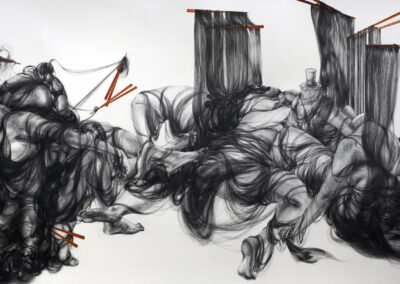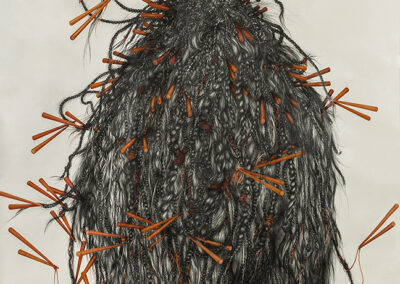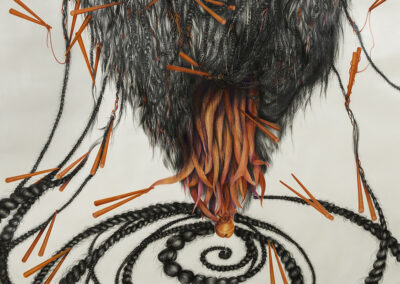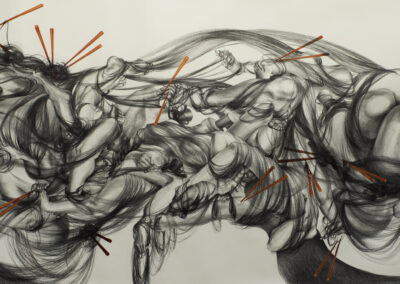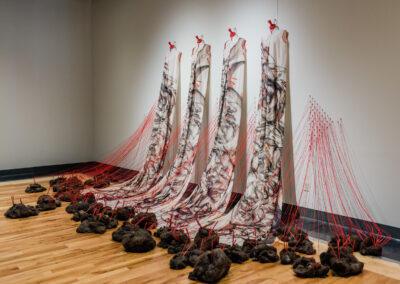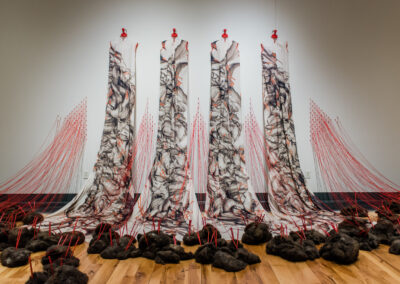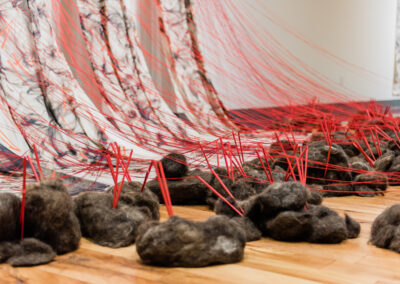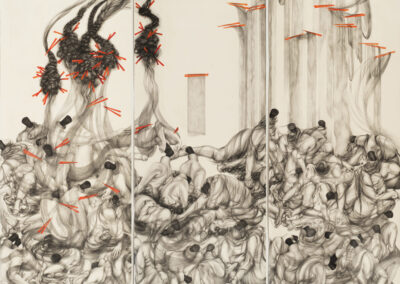People are by nature social beings. People need other people to survive, and as such they tend to perpetually seek social interactions. However, human relationships are inherently complex and multi-faceted. The ideology of the series, Lián 連 and Liàn 鏈, on view at the Turchin Center for the Visual Arts, begins with a pair of Chinese homophones “Lián 連 and Liàn 鏈” that, depending on the context, mean either “to connect” or “to enchain.” On one hand, the works portray the tensions and dynamics within human relationships; on the other, they explore how these same forces may constrict or enchain humans when negative forces come into play. While these works are in part a meditation on Taiwanese cultural traditions, they can be applied broadly to human experience itself.
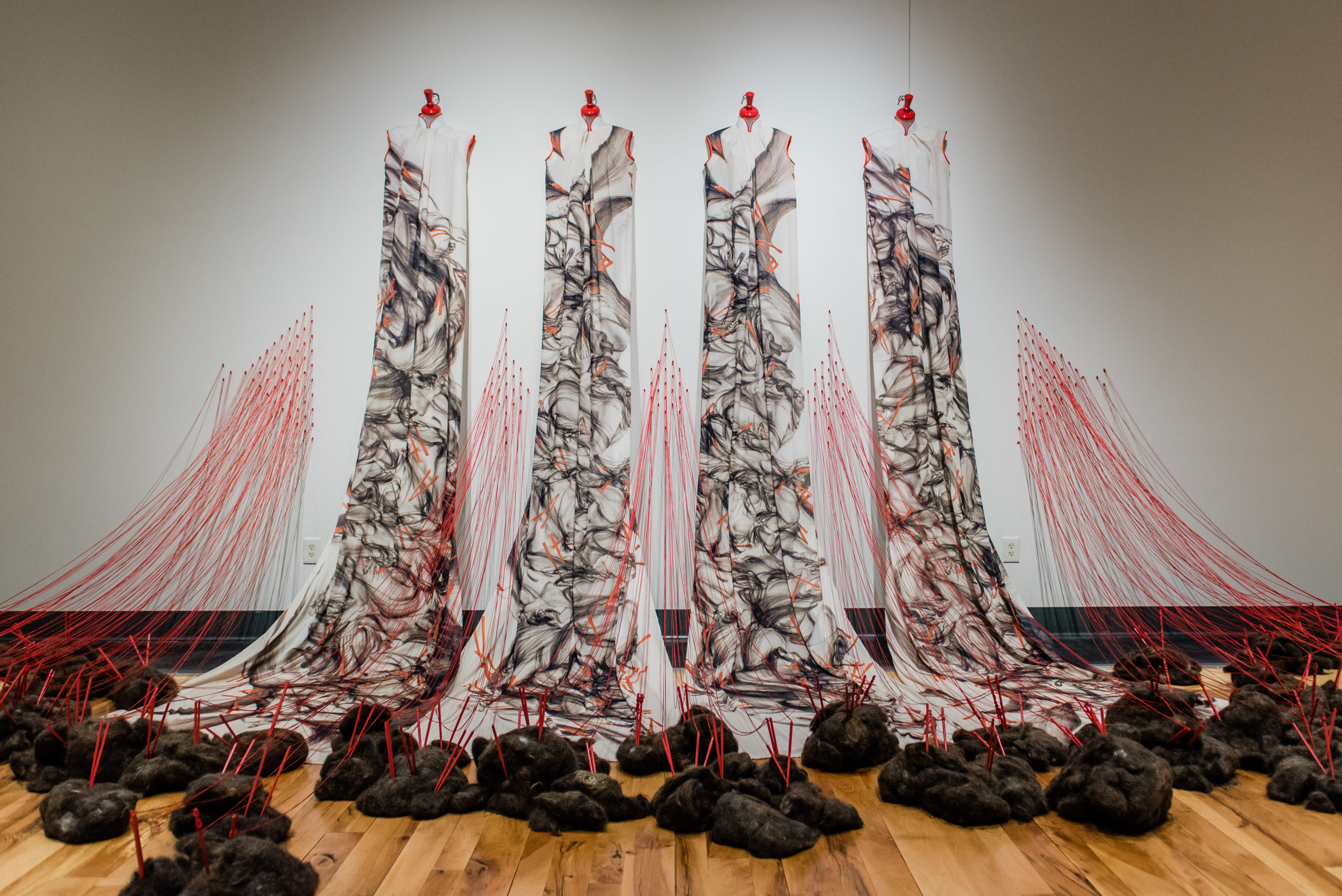
Hui Chi Lee; #11-2
Artist statement
“I have selected the qualities we associate with mannequins— plastic and figure-like, but inanimate and anonymous— as a vehicle to encourage viewers to think about these seemingly contradictory yet connected conditions. The randomly amassed mannequin-like figures in the drawings lack self-determination and appear powerless, much like many vulnerable and immobile human beings in today’s society. I want to encourage viewers to consider this human condition in a critical manner.
“Hair and chopsticks are motifs. In Chinese tradition, lengthy hair signifies the duration of a life span, an expanse of time of which we are often hardly aware. While we may acknowledge the finitude of life, time is envisioned as somehow endless. People favor stability and continuity. When one’s comfortable status is threatened or entangled by a chaotic condition, however, ambivalence is often a result. Pairs of red chopsticks act as unknown teasers— do these ambiguous teasers lift, pull, and twist the unbounded hair to snarl or to free the mannequins? What factors are driving these entanglements? My works serve as a visual riddle for viewers to decipher.
“The interplay between drawings and installations is strategically designed to resonate and yet to evoke a more direct visceral response from viewers by encouraging them not just to look, but also to participate in the exhibit. A site-specific installation of a Zen garden at the center of the exhibition provides a space for viewers to reassess and meditate on their relationship with other people. At the center of the Zen garden is a fabric sculpture made of a Chinese canopy with braided strands of human hair hanging down like a stream that connects sky and earth.”
— Hui Chi Lee
About the artist
Hui Chi Lee is an assistant professor in studio art at Appalachian State University. Lee’s artwork focuses on drawing, painting, and mixed media. She received her BFA from the University of Arizona, an MS in Art Therapy & Art Education from Illinois State University, and an MFA in Drawing and Painting from the University of Florida.
As her principle subject matter, Lee’s current body of work incorporates the human form and hair to explore dilemmas in human relationships. Her primary media include graphite and mechanical lead pencils which are used because of their unique ability to capture the subtleties and details that she seeks to emphasize. To transcend the boundaries of two-dimensional art, Lee has printed her drawn images onto textiles and incorporated human hair in site-specific installations.
Additional resources
- Flickr – Installation images
- Hui Chi Lee
- Hui Chi Lee – Page published by the Appalachian State University Department of Art.
- Hui Chi Lee’s Artwork: Calligraphy in Motion – High End Weekly; Apr. 15, 2016.
- Hui Chi Lee’s Abstract, Largescale Pen and Pencil Works – Hi-Fructose Magazine; Apr. 13, 2016.
- Looking Ahead, Looking Back: Ten Years of Asian Art (Part 4) – Asia Week New York; Sept. 17, 2018.
- Hui Chi Lee – Page published by FitzGerald Fine Arts.

